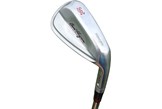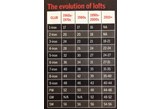Why do the lofts on irons keep getting stronger?
Published: Last updated:
-
Your 7-iron may be the same as someone else’s 5-iron
-
Lofts keep getting stronger over time
-
Expert club maker Tom Wishon says it’s so manufacturers can say new clubs go further
-
Long irons are now harder to hit
The problem is that there is no industry standard when it comes to iron lofts, meaning the ‘7’ stamped on the sole of one 7-iron may mean something very different to the ‘7’ stamped on another. The numbers help you sequence your irons, but beyond that, they are almost meaningless.
So if someone wants to hit a club with the same loft as you, they may actually need to hit an iron one or two clubs removed from the one you just hit.
In reality, when someone asks you that question, nine times out of ten it’s because they’re planning to hit a shorter club than you, and want to feel big when they tell you that they only needed a wedge to match your 8-iron. One: who cares? Two: that wedge may actually have had a very similar loft to your 8-iron!
How much do lofts vary from manufacturer to manufacturer?
A lot. Ping’s S55 7-iron has a loft of 33 degrees. TaylorMade’s RSi1 7-iron has 30.5 degrees. Callaway’s Big Bertha 7-iron has just 30 degrees of loft, which is the same as a Ping S55 6-iron and one degree less than the 6-iron in some other sets.
It’s not just differences from manufacturer to manufacturer, either. Even within manufacturers, the lofts from set to set vary considerably. The Nike VRS Covert 2.0 7-iron, for instance, has 31 degrees of loft, which is four degrees less than the 7-iron in Nike’s V Forged Combo set.
Why do lofts vary so much from one set to another?
If your clubhead is specifically designed to help you launch the ball higher (by placing weight low in the head), you need stronger lofts to create the optimum ball flight, or you’ll find the ball ballooning into the air.
Generally speaking, irons tailored to better players will have weaker lofts, as these players seek distance control and feel over increased distance.
To make things even more confusing, lofts seem to be evolving and getting stronger over time.
Why have lofts changed?
“Each year, in order to say their clubs hit further, the club companies have been tinkering with the loft angles – lowering them a bit at a time each year,” says expert club maker Tom Wishon.
“As a result, every club in the set has moved ‘up’ at least one, if not two numbers. So, when you go to the driving range for a demo day and find you are hitting a new 6-iron further than your current 5-iron, you now know why. It’s because the shiny new 6-iron in your hands was a 5-iron only a few years ago, and probably a 4-iron a few years before that.”

Isn’t more distance a good thing, anyway?
Looking at that question in isolation, the answer may well be yes. Being able to hit your 7-iron 160 yards instead of 150 yards sounds like it will help your game – and well it might.
The problems come with your long and short irons. As lofts have gotten stronger, a 3-iron that may once have offered 21 degrees of loft now has just 17 degrees, making it very hard for most amateurs to hit. That’s why fewer and fewer of us now carry 3-irons, instead favouring easier-to-hit hybrids.
At the other end of your set, it might be nice for your ego to hit your pitching wedge 150 yards and your sand wedge 130 yards, but what are you going to hit when you’re 100 yards from the pin? Distance gaps have increased, which means you either need to plug the gaps by carrying more wedges, or become more creative by hitting less-than-full shots.
What can I do about it?
The main thing you need to do is pay attention to how far you hit each club, rather than what number is written on it. Keep a track of the average distance you get with each club, and either remember them, keep a list handy when you’re on the course, or even write the yardage on the bottom of each club.
And don’t compare distances with other golfers. Don’t hit a 7-iron purely because your partner just popped his 7-iron on the green. The club he used may be equivalent to your 5-iron!
What would you rather hit: a club that has the same number printed on it as someone else, or the club that’s going to give you a birdie putt?
-
In the market for some new irons? Check out all our irons reviews



